heater DODGE AVENGER 2008 Owners Manual
[x] Cancel search | Manufacturer: DODGE, Model Year: 2008, Model line: AVENGER, Model: DODGE AVENGER 2008Pages: 467, PDF Size: 7.16 MB
Page 118 of 467
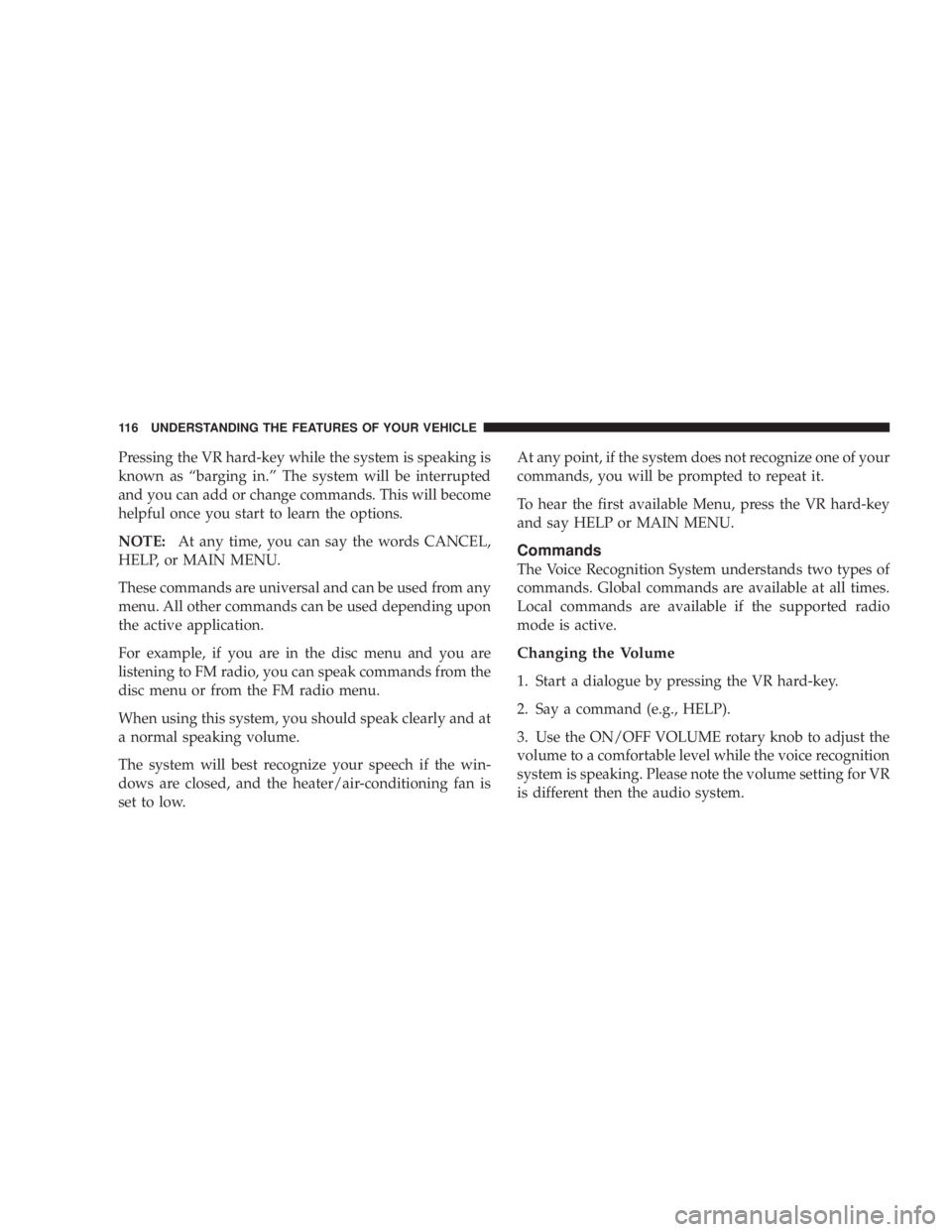
Pressing the VR hard-key while the system is speaking is
known as ªbarging in.º The system will be interrupted
and you can add or change commands. This will become
helpful once you start to learn the options.
NOTE: At any time, you can say the words CANCEL,
HELP, or MAIN MENU.
These commands are universal and can be used from any
menu. All other commands can be used depending upon
the active application.
For example, if you are in the disc menu and you are
listening to FM radio, you can speak commands from the
disc menu or from the FM radio menu.
When using this system, you should speak clearly and at
a normal speaking volume.
The system will best recognize your speech if the win-
dows are closed, and the heater/air-conditioning fan is
set to low. At any point, if the system does not recognize one of your
commands, you will be prompted to repeat it.
To hear the first available Menu, press the VR hard-key
and say HELP or MAIN MENU.
Commands
The Voice Recognition System understands two types of
commands. Global commands are available at all times.
Local commands are available if the supported radio
mode is active.
Changing the Volume
1. Start a dialogue by pressing the VR hard-key.
2. Say a command (e.g., HELP).
3. Use the ON/OFF VOLUME rotary knob to adjust the
volume to a comfortable level while the voice recognition
system is speaking. Please note the volume setting for VR
is different then the audio system.116 UNDERSTANDING THE FEATURES OF YOUR VEHICLE
Page 125 of 467
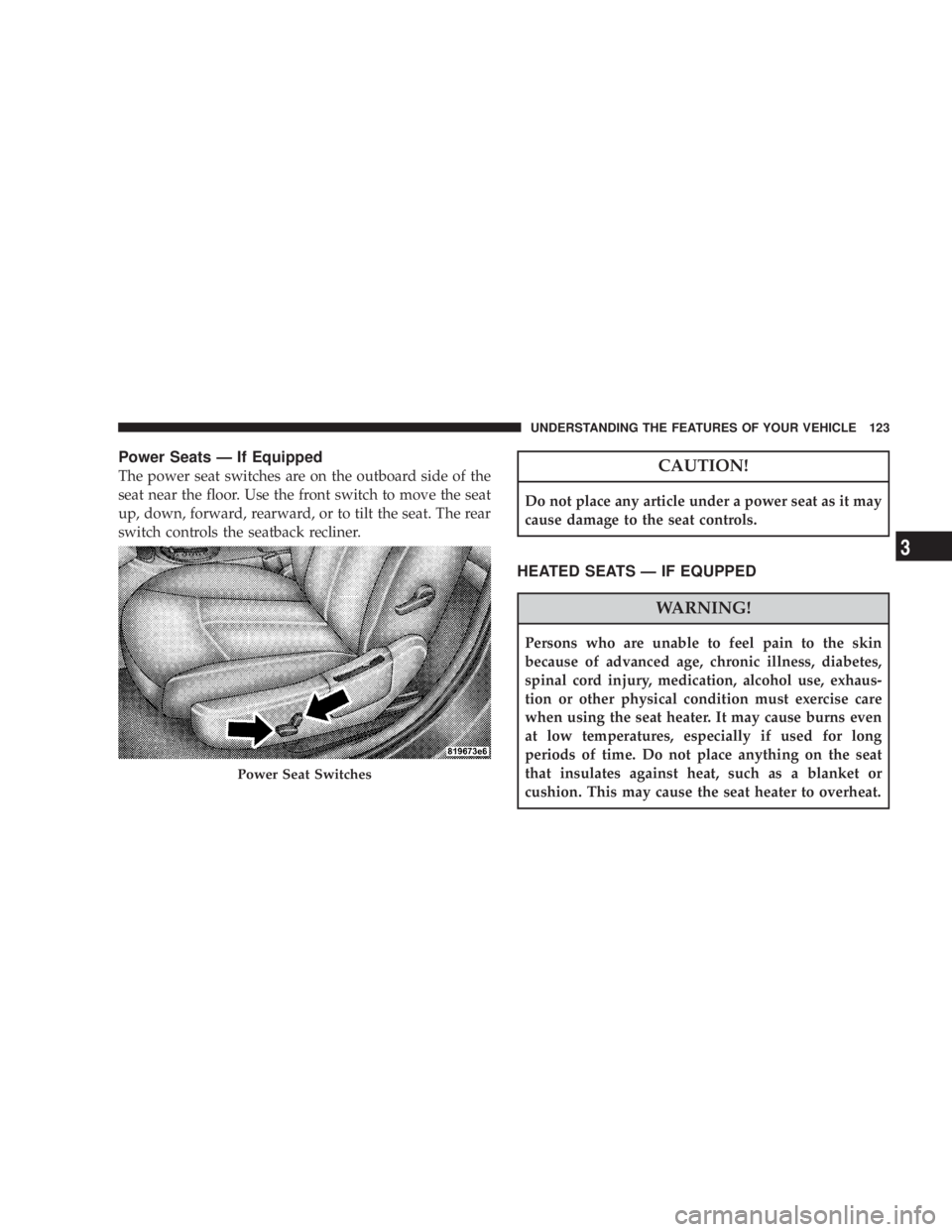
Power Seats Ð If Equipped
The power seat switches are on the outboard side of the
seat near the floor. Use the front switch to move the seat
up, down, forward, rearward, or to tilt the seat. The rear
switch controls the seatback recliner.
CAUTION!Do not place any article under a power seat as it may
cause damage to the seat controls.
HEATED SEATS Ð IF EQUPPED
WARNING!Persons who are unable to feel pain to the skin
because of advanced age, chronic illness, diabetes,
spinal cord injury, medication, alcohol use, exhaus-
tion or other physical condition must exercise care
when using the seat heater. It may cause burns even
at low temperatures, especially if used for long
periods of time. Do not place anything on the seat
that insulates against heat, such as a blanket or
cushion. This may cause the seat heater to overheat.Power Seat Switches UNDERSTANDING THE FEATURES OF YOUR VEHICLE 123
3
Page 172 of 467
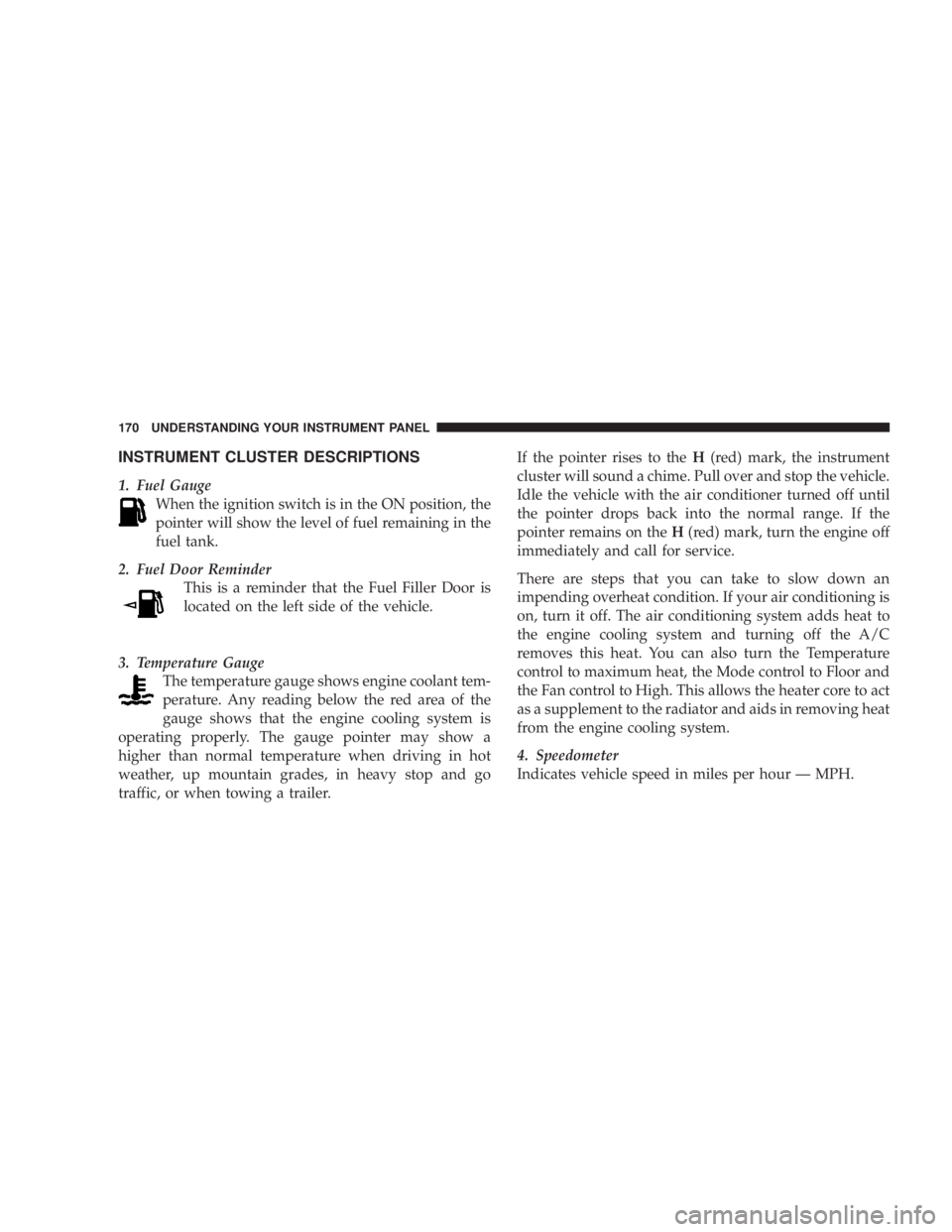
INSTRUMENT CLUSTER DESCRIPTIONS
1. Fuel Gauge
When the ignition switch is in the ON position, the
pointer will show the level of fuel remaining in the
fuel tank.
2. Fuel Door Reminder
This is a reminder that the Fuel Filler Door is
located on the left side of the vehicle.
3. Temperature Gauge
The temperature gauge shows engine coolant tem-
perature. Any reading below the red area of the
gauge shows that the engine cooling system is
operating properly. The gauge pointer may show a
higher than normal temperature when driving in hot
weather, up mountain grades, in heavy stop and go
traffic, or when towing a trailer. If the pointer rises to the H (red) mark, the instrument
cluster will sound a chime. Pull over and stop the vehicle.
Idle the vehicle with the air conditioner turned off until
the pointer drops back into the normal range. If the
pointer remains on the H (red) mark, turn the engine off
immediately and call for service.
There are steps that you can take to slow down an
impending overheat condition. If your air conditioning is
on, turn it off. The air conditioning system adds heat to
the engine cooling system and turning off the A/C
removes this heat. You can also turn the Temperature
control to maximum heat, the Mode control to Floor and
the Fan control to High. This allows the heater core to act
as a supplement to the radiator and aids in removing heat
from the engine cooling system.
4. Speedometer
Indicates vehicle speed in miles per hour Ð MPH.170 UNDERSTANDING YOUR INSTRUMENT PANEL
Page 259 of 467
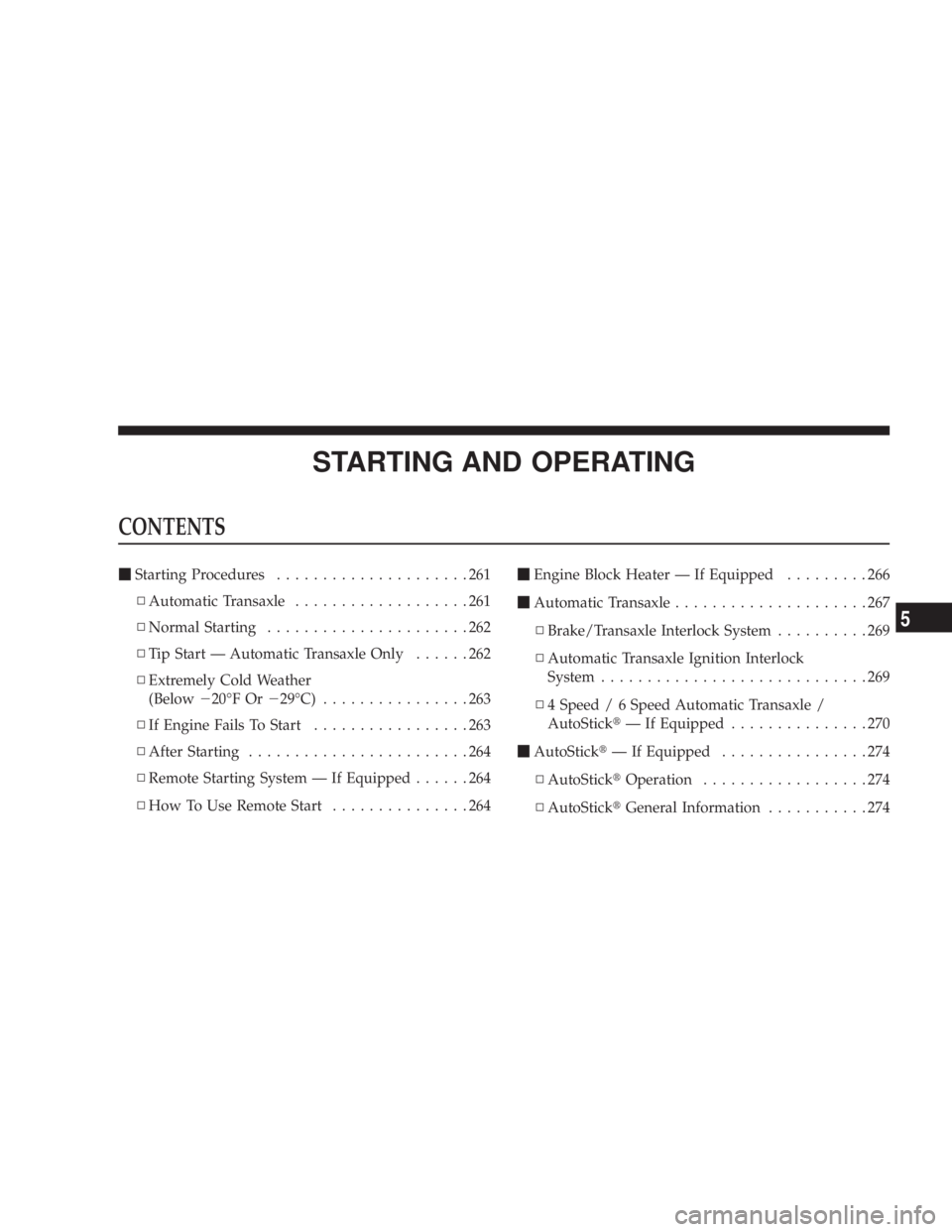
STARTING AND OPERATINGCONTENTS m Starting Procedures .....................261
N Automatic Transaxle ...................261
N Normal Starting ......................262
N Tip Start Ð Automatic Transaxle Only ......262
N Extremely Cold Weather
(Below 2 20ÉF Or 2 29ÉC) ................263
N If Engine Fails To Start .................263
N After Starting ........................264
N Remote Starting System Ð If Equippe d......264
N How To Use Remote Start ...............264 m Engine Block Heater Ð If Equipped .........266
m Automatic Transaxle .....................267
N Brake/Transaxle Interlock System ..........269
N Automatic Transaxle Ignition Interlock
System .............................269
N 4 Speed / 6 Speed Automatic Transaxle /
AutoStick t Ð If Equipped ...............270
m AutoStick t Ð If Equipped ................274
N AutoStick t Operation ..................274
N AutoStick t General Information ...........2745
Page 265 of 467
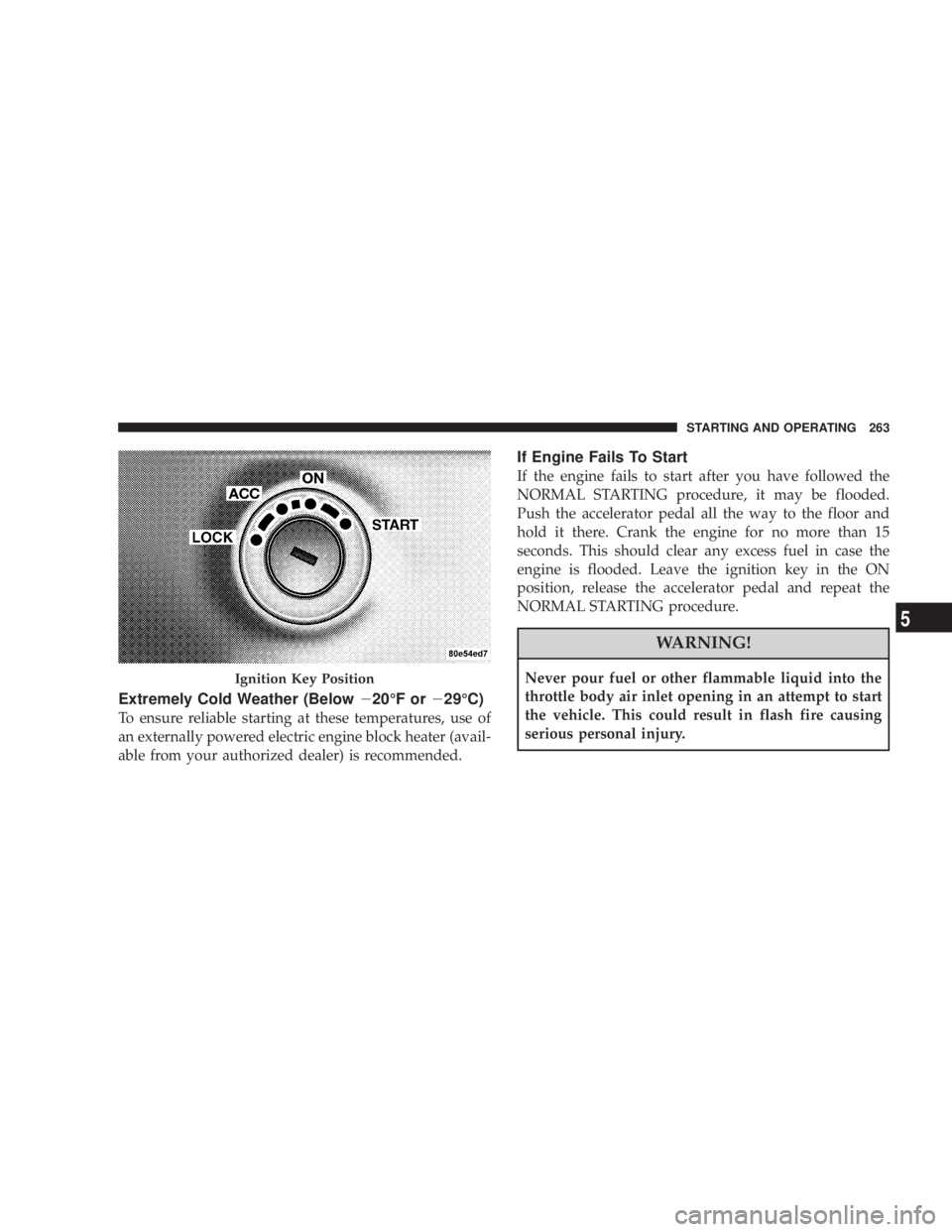
Extremely Cold Weather (Below 2 20ÉF or 2 29ÉC)
To ensure reliable starting at these temperatures, use of
an externally powered electric engine block heater (avail-
able from your authorized dealer) is recommended. If Engine Fails To Start
If the engine fails to start after you have followed the
NORMAL STARTING procedure, it may be flooded.
Push the accelerator pedal all the way to the floor and
hold it there. Crank the engine for no more than 15
seconds. This should clear any excess fuel in case the
engine is flooded. Leave the ignition key in the ON
position, release the accelerator pedal and repeat the
NORMAL STARTING procedure.
WARNING!Never pour fuel or other flammable liquid into the
throttle body air inlet opening in an attempt to start
the vehicle. This could result in flash fire causing
serious personal injury.Ignition Key Position STARTING AND OPERATING 263
5
Page 268 of 467
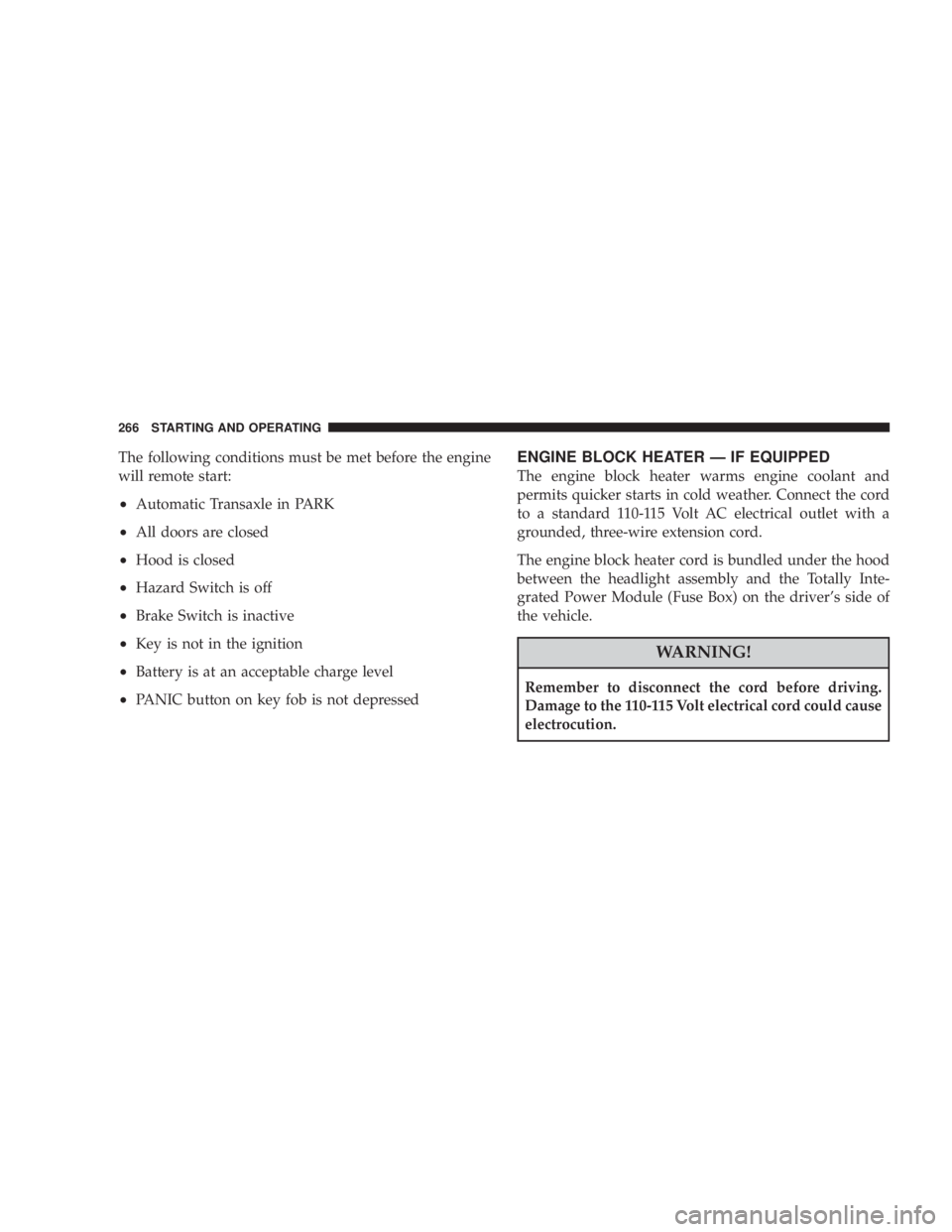
The following conditions must be met before the engine
will remote start:
² Automatic Transaxle in PARK
² All doors are closed
² Hood is closed
² Hazard Switch is off
² Brake Switch is inactive
² Key is not in the ignition
² Battery is at an acceptable charge level
² PANIC button on key fob is not depressed ENGINE BLOCK HEATER Ð IF EQUIPPED
The engine block heater warms engine coolant and
permits quicker starts in cold weather. Connect the cord
to a standard 110-115 Volt AC electrical outlet with a
grounded, three-wire extension cord.
The engine block heater cord is bundled under the hood
between the headlight assembly and the Totally Inte-
grated Power Module (Fuse Box) on the driver's side of
the vehicle.
WARNING!Remember to disconnect the cord before driving.
Damage to the 110-115 Volt electrical cord could cause
electrocution.266 STARTING AND OPERATING
Page 351 of 467

NOTE: There are steps that you can take to slow down
an impending overheat condition. If your air conditioner
is on, turn it off. The air conditioning system adds heat to
the engine cooling system and turning off the A/C
removes this heat. You can also turn the Temperature
control to maximum heat, the Mode control to floor, and
the fan control to High. This allows the heater core to act
as a supplement to the radiator and aids in removing heat
from the engine cooling system. CAUTION!Driving with a hot cooling system could damage
your vehicle. If temperature gauge reads ªHº, pull
over and stop the vehicle with the engine at idle,
when safe. Turn the air conditioner off and wait until
the pointer drops back into the normal range. After
appropriate action has been taken, if the pointer
remains on the ªHº, turn the engine off immediately,
and call for service. WHAT TO DO IN EMERGENCIES 349
6
Page 361 of 467
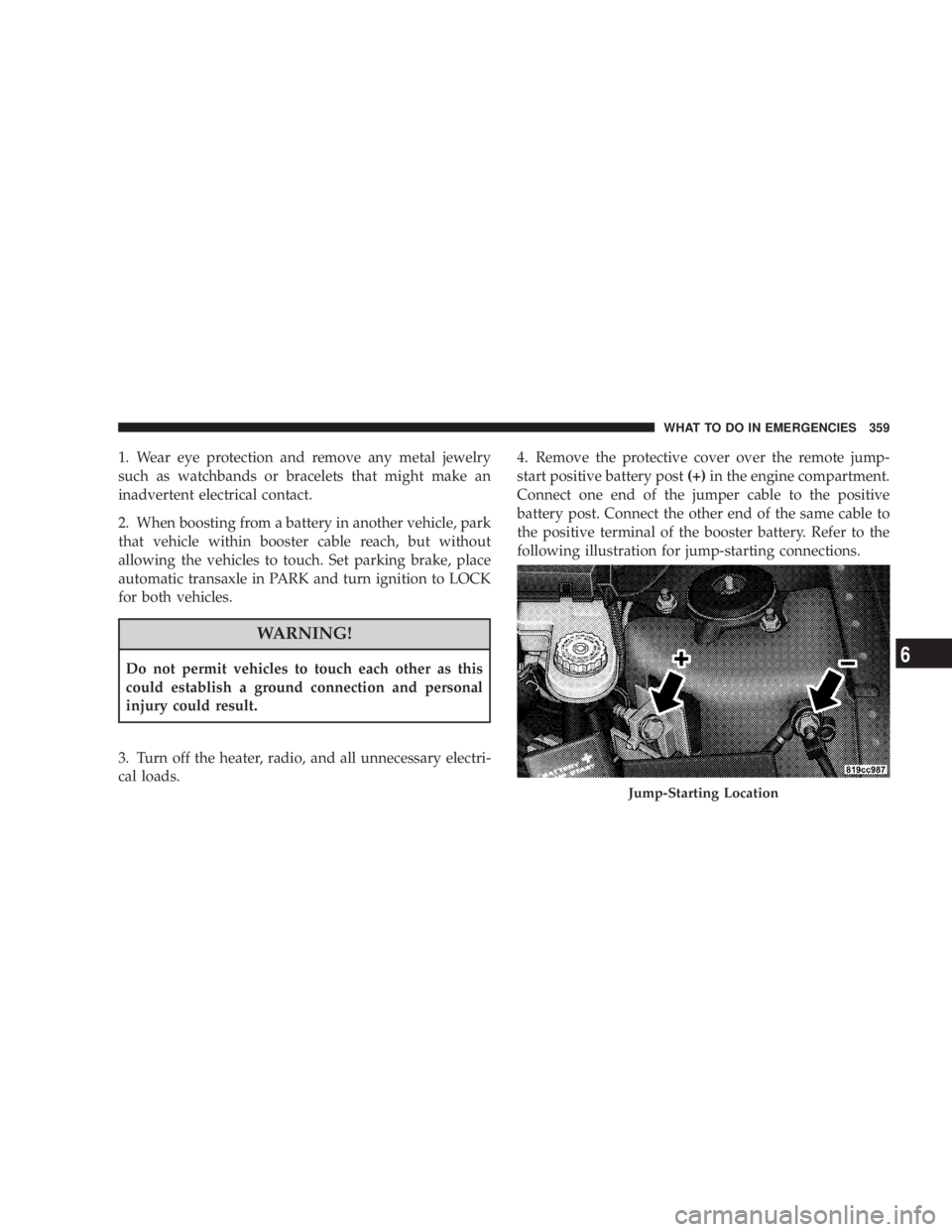
1. Wear eye protection and remove any metal jewelry
such as watchbands or bracelets that might make an
inadvertent electrical contact.
2. When boosting from a battery in another vehicle, park
that vehicle within booster cable reach, but without
allowing the vehicles to touch. Set parking brake, place
automatic transaxle in PARK and turn ignition to LOCK
for both vehicles.
WARNING!Do not permit vehicles to touch each other as this
could establish a ground connection and personal
injury could result.
3. Turn off the heater, radio, and all unnecessary electri-
cal loads. 4. Remove the protective cover over the remote jump-
start positive battery post (+) in the engine compartment.
Connect one end of the jumper cable to the positive
battery post. Connect the other end of the same cable to
the positive terminal of the booster battery. Refer to the
following illustration for jump-starting connections.
Jump-Starting Location WHAT TO DO IN EMERGENCIES 359
6
Page 423 of 467
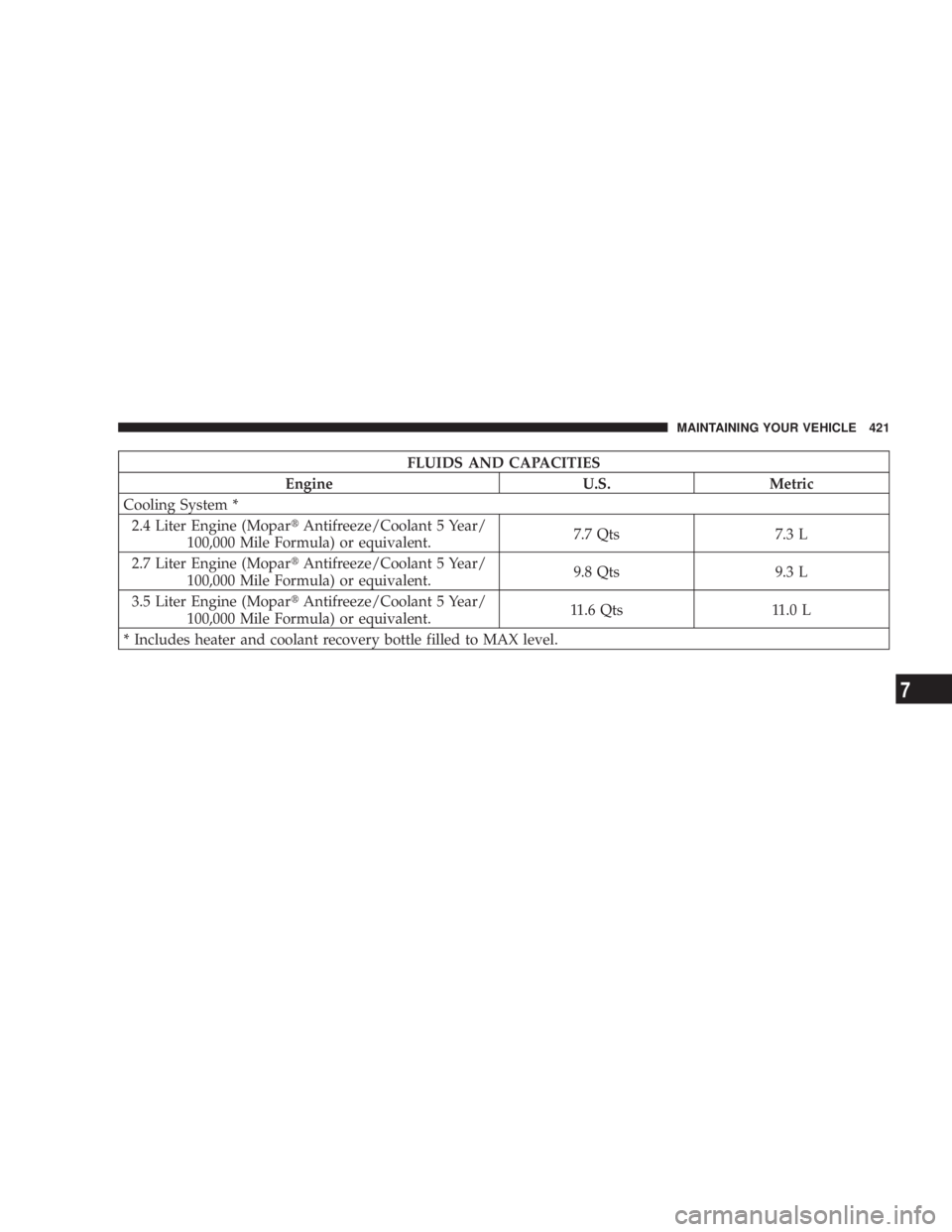
FLUIDS AND CAPACITIES
Engine U.S. Metric
Cooling System *
2.4 Liter Engine (Mopar t Antifreeze/Coolant 5 Year/
100,000 Mile Formula) or equivalent. 7.7 Qts 7.3 L
2.7 Liter Engine (Mopar t Antifreeze/Coolant 5 Year/
100,000 Mile Formula) or equivalent. 9.8 Qts 9.3 L
3.5 Liter Engine (Mopar t Antifreeze/Coolant 5 Year/
100,000 Mile Formula) or equivalent. 11.6 Qts 11.0 L
* Includes heater and coolant recovery bottle filled to MAX level. MAINTAINING YOUR VEHICLE 421
7
Page 450 of 467
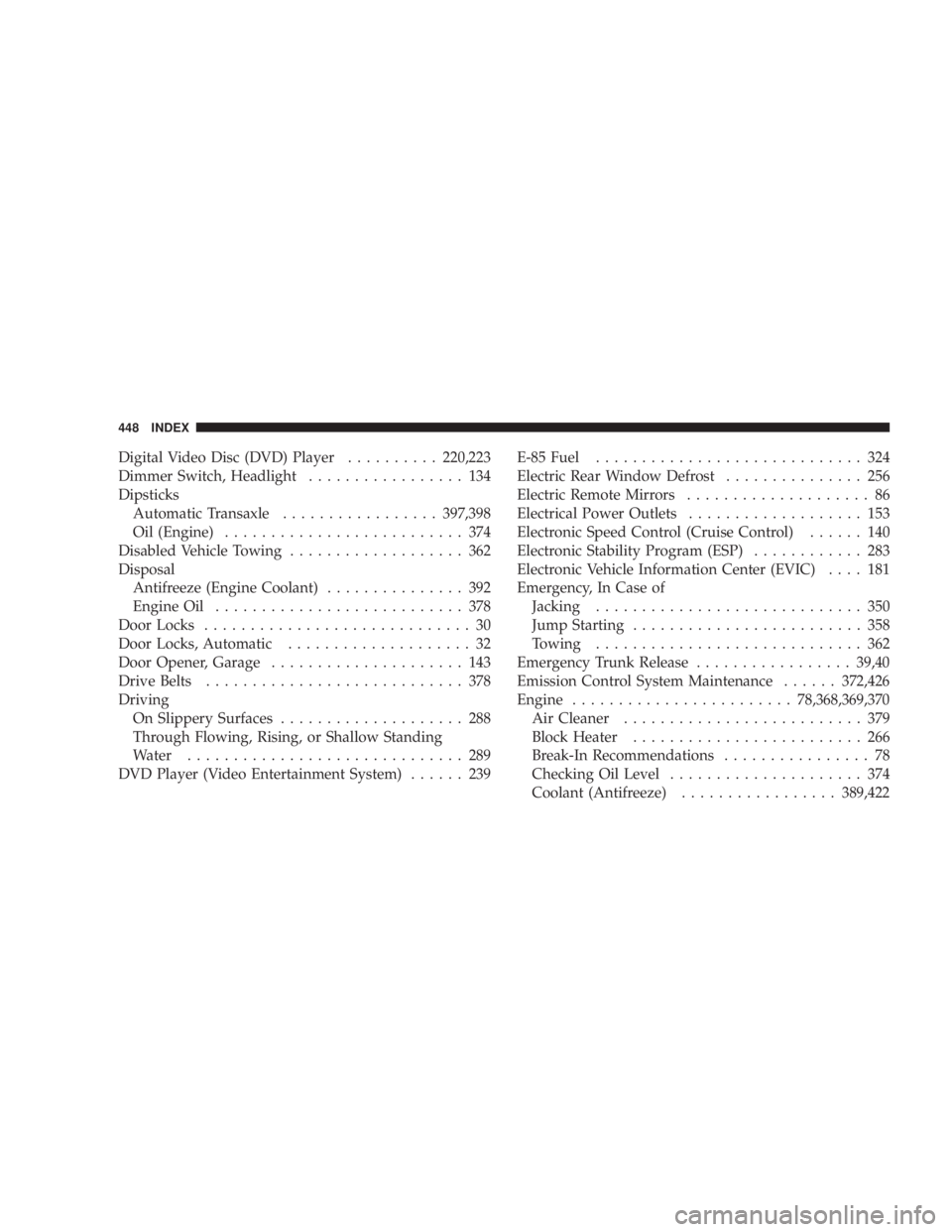
Digital Video Disc (DVD) Player .......... 220,223
Dimmer Switch, Headlight ................. 134
Dipsticks
Automatic Transaxle ................. 397,398
Oil (Engine) .......................... 374
Disabled Vehicle Towing ................... 362
Disposal
Antifreeze (Engine Coolant) ............... 392
Engine Oil ........................... 378
Door Locks ............................. 30
Door Locks, Automatic .................... 32
Door Opener, Garage ..................... 143
Drive Belts ............................ 378
Driving
On Slippery Surfaces .................... 288
Through Flowing, Rising, or Shallow Standing
Water .............................. 289
DVD Player (Video Entertainment System) ...... 239 E-85 Fuel ............................. 324
Electric Rear Window Defrost ............... 256
Electric Remote Mirrors .................... 86
Electrical Power Outlets ................... 153
Electronic Speed Control (Cruise Control) ...... 140
Electronic Stability Program (ESP) ............ 283
Electronic Vehicle Information Center (EVIC) .... 181
Emergency, In Case of
Jacking ............................. 350
Jump Starting ......................... 358
Towing ............................. 362
Emergency Trunk Release ................. 39,40
Emission Control System Maintenance ...... 372,426
Engine ........................ 78,368,369,370
Air Cleaner .......................... 379
Block Heater ......................... 266
Break-In Recommendations ................ 78
Checking Oil Level ..................... 374
Coolant (Antifreeze) ................. 389,422448 INDEX